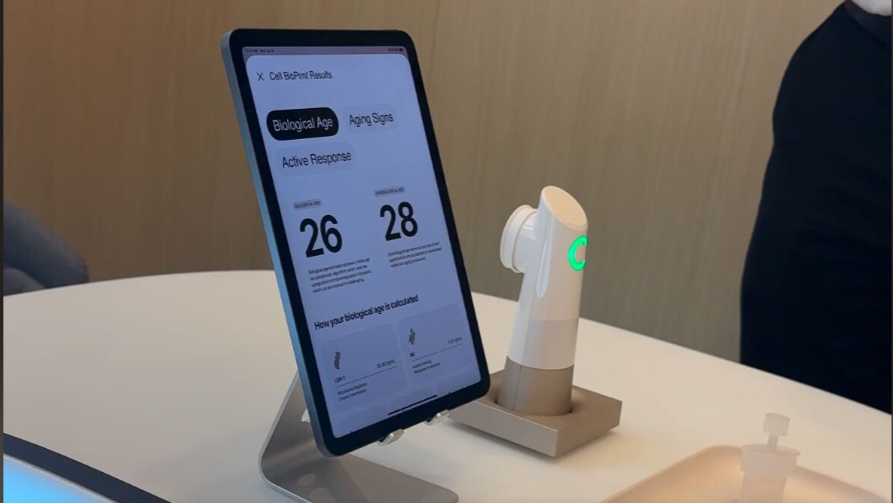
As someone who takes a fairly laissez-faire approach to skincare despite having storied difficulties with acne and oiliness, I’m excited to see that beauty tech is on the rise. This year at CES 2025, I saw everything from LED face masks to smart mirrors making debut appearances alongside the latest and greatest gadgetry, however, one of the most exciting arrivals was L'Oréal’s new skin testing device, the Cell Bioprint.
Made in collaboration with Korean start-up Nanoentek, this tabletop device uses advanced proteomics (the study of how protein composition affects skin aging) to determine the past, present and future of your skin health, all in a five-minute test.
I had the opportunity to try it out on-site, and I learned a lot about my skin, including some surprising insights I’ll be taking heed of in my new skincare regime.
Want a quick run-down? Check out the timestamped video below.
Lab on a chip
So, how does the Cell BioPrint actually work? The test itself is deceptively simple, but the science behind the scenes is truly impressive.
The test begins by dabbing stickers on the apple of your cheeks 15 times, before inserting them into a solution. The sticker lifts dead skin cells from your cheek, which the solution then strips, leaving behind only the tell-tale proteins identified by L'Oréal as biomarkers for various signs of skin aging.
Next up, you’ll need one of L'Oréal’s “lab on a chip” testing cartridges, on which you’ll dot a few drops of the solution. Much like the lateral flow tests we were so familiar with during the pandemic, this cartridge sucks up the solution; and this is where the actual Cell BioPrint machine comes into play. It features an ATM-esque slot, into which you slide the testing cartridge so it can be measured and analyzed.
While you wait for the analysis to be complete, you’ll also take a few scans of your cheeks and forehead with L'Oréal’s Skin Connect device and answer a short questionnaire about your chronological age and skin type before the machine spits back out your testing cartridge and delivers your results on the connected tablet.
By the skin of my skin
@techradar ♬ original sound - TechRadar
Now, as I mentioned before, I’m no skincare guru, despite a now-decades-long battle with my own complexion. So, anything that removes the guesswork for me is a huge win in my book.
Suffice it to say, then, that I was delighted by the depth and detail of my skincare report from the Cell BioPrint. Not only did give me some great insight into my skin, but it also told me that my skin’s biological age is actually two years younger than my biological age - a compliment I was not expecting to receive.
In addition to correctly identifying that my skin tends towards larger pores and oiliness, I also learned that my skin barrier function is weak, and that there’s some unevenness to my skin. One of the most useful learnings is that my skin absorbs retinol well, meaning I can confidently join the leagues of TikTok-informed skincare gurus in worshipping the famous form of Vitamin A.

Better yet, the device can even recommend specific products for your skin composition. Of course, the recommendations made by the Cell BioPrint are solely from L'Oréal’s family of products, so there’s that to consider; but you can always research for yourself any product dupes or alternatives that fall within your price range or preference.
Having spent years hopping from product to product, I’m feeling a lot more confident about my skincare regimen following my demonstration of L'Oréal’s Cell BioPrint device; but that’s not just down to the tech itself. Cell BioPrint is destined more for department stores and retail environments instead of for home use, meaning users will have an expert at-hand to help break down the results; an important element in today’s age of misinformation.
With a pilot due in Asia later this year, it’s hopefully only a matter of time before this technology lands in a store near you; I’ll race you to the front of the line to see if I can maintain my two-year skin age gap.
You might also like…
- The 25 best gadgets we saw at CES 2025, from next-gen TVs to better portable gaming to a smart grill
- CES 2025 proves AI is everywhere, unstoppable, and perhaps just how you want it
- CES 2025 day 3: the 11 best gadgets we've seen, from Lenovo's rollable laptop to Panasonic's new flagship OLED TV
TechRadar extensively covered this year's CES, bringing you all of the big announcements as they happened. Head over to our CES 2025 news page for the latest stories and our hands-on verdicts on everything from 8K TVs and foldable displays to new phones, laptops, smart home gadgets, and the latest in AI.
And don’t forget to follow us on TikTok and WhatsApp for the latest from the CES show floor!







